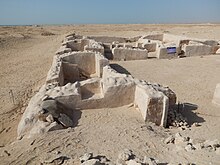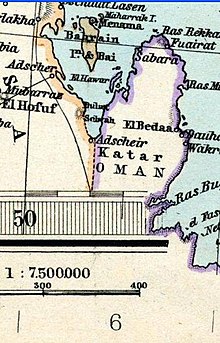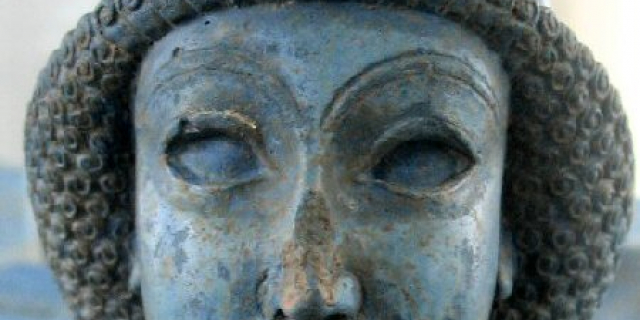Qatar
Context of Qatar
Qatar (UK: , US: ; Arabic: قطر, romanized: Qaṭar [ˈqɑtˤɑr]; local vernacular pronunciation: [ˈɡɪtˤɑr]), officially the State of Qatar, is a country in Western Asia. It occupies the Qatar Peninsula on the northeastern coast of the Arabian Peninsula in the Middle East; it shares its sole land border with Saudi Arabia to the south, with the rest of its territory surrounded by the Persian Gulf. The Gulf of Bahrain, an inlet of the Persian Gulf, separates Qatar from nearby Bahrain. The capital is Doha, home to over 80% of the country's inhabitan...Read more
Qatar (UK: , US: ; Arabic: قطر, romanized: Qaṭar [ˈqɑtˤɑr]; local vernacular pronunciation: [ˈɡɪtˤɑr]), officially the State of Qatar, is a country in Western Asia. It occupies the Qatar Peninsula on the northeastern coast of the Arabian Peninsula in the Middle East; it shares its sole land border with Saudi Arabia to the south, with the rest of its territory surrounded by the Persian Gulf. The Gulf of Bahrain, an inlet of the Persian Gulf, separates Qatar from nearby Bahrain. The capital is Doha, home to over 80% of the country's inhabitants, and the land area is mostly made up of flat, low-lying desert.
Qatar has been ruled as a hereditary monarchy by the House of Thani since Mohammed bin Thani signed a treaty with the British in 1868 that recognised its separate status. Following Ottoman rule, Qatar became a British protectorate in 1916, and gained independence in 1971. The current emir is Tamim bin Hamad Al Thani, who holds nearly all executive and legislative authority under the Constitution of Qatar, as well as controlling the judiciary. He appoints the prime minister and cabinet. The partially-elected Consultative Assembly can block legislation and has a limited ability to dismiss ministers.
In early 2017, the total population of Qatar was 2.6 million, with 313,000 of them Qatari citizens and 2.3 million expatriates. Its official religion is Islam. In terms of income, the country has the fourth-highest GDP (PPP) per capita in the world, and the eleventh-highest GNI per capita (Atlas method). Qatar ranks 42nd in the Human Development Index, the third-highest HDI in the Arab world. It is a high-income economy, backed by the world's third-largest natural gas reserves and oil reserves. Qatar is one of the world's largest exporters of liquefied natural gas, and the world's largest emitter of carbon dioxide per capita.
In the 21st century, Qatar emerged as a middle power in the Arab world through its resource-wealth, as well as its globally expanding media group, Al Jazeera Media Network, and reportedly supporting several rebel groups financially during the Arab Spring. Qatar forms part of the Gulf Cooperation Council. Qatar's human rights record has been regarded by academics and non-governmental organisations as being generally poor, with restrictions on civil liberties such as the freedoms of association, expression and the press, as well as its treatment of thousands of migrant workers amounting to forced labour for projects in the country.
More about Qatar
- Currency Qatari riyal
- Calling code +974
- Internet domain .qa
- Mains voltage 240V/50Hz
- Democracy index 3.24
- Population 2639211
- Area 11437
- Driving side right
- Antiquity
 Excavation of a Kassite dye site on Al Khor Island
Excavation of a Kassite dye site on Al Khor IslandHuman habitation in Qatar dates back to 50,000 years ago.[1] Settlements and tools dating back to the Stone Age have been unearthed in the peninsula.[1] Mesopotamian artifacts originating from the Ubaid period (c. 6500–3800 BC) have been discovered in abandoned coastal settlements.[2] Al Da'asa, a settlement located on the western coast of Qatar, is the most important Ubaid site in the country and is believed to have accommodated a small seasonal encampment.[3][4]
...Read moreAntiquityRead less Excavation of a Kassite dye site on Al Khor Island
Excavation of a Kassite dye site on Al Khor IslandHuman habitation in Qatar dates back to 50,000 years ago.[1] Settlements and tools dating back to the Stone Age have been unearthed in the peninsula.[1] Mesopotamian artifacts originating from the Ubaid period (c. 6500–3800 BC) have been discovered in abandoned coastal settlements.[2] Al Da'asa, a settlement located on the western coast of Qatar, is the most important Ubaid site in the country and is believed to have accommodated a small seasonal encampment.[3][4]
Kassite Babylonian material dating back to the second millennium BC found in Al Khor Islands attests to trade relations between the inhabitants of Qatar and the Kassites in modern-day Bahrain.[5] Among the findings were 3,000,000 crushed snail shells and Kassite potsherds.[3] It has been suggested that Qatar is the earliest known site of shellfish dye production, owing to a Kassite purple dye industry which existed on the coast.[2][6]
In 224 AD, the Sasanian Empire gained control over the territories surrounding the Persian Gulf.[7] Qatar played a role in the commercial activity of the Sasanids, contributing at least two commodities: precious pearls and purple dye.[citation needed] Under the Sasanid reign, many of the inhabitants in Eastern Arabia were introduced to Christianity following the eastward dispersal of the religion by Mesopotamian Christians.[8] Monasteries were constructed and further settlements were founded during this era.[9][10] During the latter part of the Christian era, Qatar comprised a region known as 'Beth Qatraye' (Syriac for "house of the Qataris").[11] The region was not limited to Qatar; it also included Bahrain, Tarout Island, Al-Khatt, and Al-Hasa.[12]
In 628, the Islamic prophet Muhammad sent a Muslim envoy to a ruler in Eastern Arabia named Munzir ibn Sawa Al Tamimi and requested that he and his subjects accept Islam. Munzir obliged his request, and accordingly, most of the Arab tribes in the region converted to Islam.[13] In the middle of the century, the Muslim conquest of Persia would result in the fall of the Sasanian Empire.[14]
Early and late Islamic period (661–1783)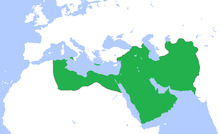 Abbasid Caliphate at its greatest extent, c. 850
Abbasid Caliphate at its greatest extent, c. 850Qatar was described as a famous horse and camel breeding centre during the Umayyad period.[15] In the 8th century, it started benefiting from its commercially strategic position in the Persian Gulf and went on to become a centre of pearl trading.[16][17]
Substantial development in the pearling industry around the Qatari Peninsula occurred during the Abbasid era.[15] Ships voyaging from Basra to India and China would make stops in Qatar's ports during this period. Chinese porcelain, West African coins, and artefacts from Thailand have been discovered in Qatar.[14] Archaeological remains from the 9th century suggest that Qatar's inhabitants used greater wealth to construct higher quality homes and public buildings. Over 100 stone-built houses, two mosques, and an Abbasid fort were constructed in Murwab during this period.[18][19] When the caliphate's prosperity declined in Iraq, so too did it in Qatar.[20] Qatar is mentioned in 13th-century Muslim scholar Yaqut al-Hamawi's book, Mu'jam Al-Buldan, which alludes to the Qataris' fine striped woven cloaks and their skills in improvement and finishing of spears.[21]
Much of Eastern Arabia was controlled by the Usfurids in 1253, but control of the region was seized by the prince of Ormus in 1320.[22] Qatar's pearls provided the kingdom with one of its main sources of income.[23] In 1515, Manuel I of Portugal vassalised the Kingdom of Ormus. Portugal went on to seize a significant portion of Eastern Arabia in 1521.[23][24] In 1550, the inhabitants of Al-Hasa voluntarily submitted to the rule of the Ottomans, preferring them to the Portuguese.[25] Having retained a negligible military presence in the area, the Ottomans were expelled by the Bani Khalid tribe and their emirate in 1670.[26]
Bahraini and Saudi rule (1783–1868) A 1794 map by Samuel Dunn depicting Catura (at centre) in the Historical region of Bahrain.
A 1794 map by Samuel Dunn depicting Catura (at centre) in the Historical region of Bahrain.In 1766, members of the Al Khalifa family of the Utub tribal confederation migrated from Kuwait to Zubarah in Qatar.[27][28] By the time of their arrival, the Bani Khalid exercised weak authority over the peninsula, notwithstanding the fact that the largest village was ruled by their distant kin.[29] In 1783, Qatar-based Bani Utbah clans and allied Arab tribes invaded and annexed Bahrain from the Persians. The Al Khalifa imposed their authority over Bahrain and retained their jurisdiction over Zubarah.[27]
A partially restored section of the ruined town of Zubarah.Following his swearing-in as crown prince of the Wahhabi in 1788, Saud ibn Abd al-Aziz moved to expand Wahhabi territory eastward towards the Persian Gulf and Qatar. After defeating the Bani Khalid in 1795, the Wahhabi were attacked on two fronts. The Ottomans and Egyptians assaulted the western front, while the Al Khalifa in Bahrain and the Omanis launched an attack against the eastern front.[30][31] Upon being made aware of the Egyptian advance on the western frontier in 1811, the Wahhabi amir reduced his garrisons in Bahrain and Zubarah in order to redeploy his troops. Said bin Sultan, ruler of Muscat, capitalised on this opportunity and raided the Wahhabi garrisons on the eastern coast, setting fire to the fort in Zubarah. The Al Khalifa was effectively returned to power thereafter.[31]
As punishment for piracy, an East India Company vessel bombarded Doha in 1821, destroying the town and forcing hundreds of residents to flee. In 1825, the House of Thani was established with Sheikh Mohammed bin Thani as the first leader.[32]
Although Qatar was considered a dependency of Bahrain, the Al Khalifa faced opposition from the local tribes. In 1867, the Al Khalifa, along with the ruler of Abu Dhabi, sent a massive naval force to Al Wakrah in an effort to crush the Qatari rebels. This resulted in the maritime Qatari–Bahraini War of 1867–1868, in which Bahraini and Abu Dhabi forces sacked and looted Doha and Al Wakrah.[33] The Bahraini hostilities were in violation of the Perpetual Truce of Peace and Friendship of 1861. The joint incursion, in addition to the Qatari counter-attack, prompted British Political Resident, Colonel Lewis Pelly to impose a settlement in 1868. His mission to Bahrain and Qatar and the resulting peace treaty were milestones because they implicitly recognised the distinctness of Qatar from Bahrain and explicitly acknowledged the position of Mohammed bin Thani. In addition to censuring Bahrain for its breach of agreement, Pelly negotiated with Qatari sheikhs, who were represented by Mohammed bin Thani.[34] The negotiations were the first stage in the development of Qatar as a sheikhdom.[35] However, Qatar was not officially recognised as a British protectorate until 1916.[36]
The Ottoman period (1871–1915)Qatar in an 1891 map by Adolf Stieler, with Al Bidda as the major settlement Old city of Doha, January 1904
Old city of Doha, January 1904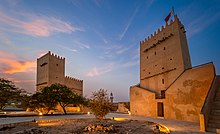 Barzan Towers are watchtowers that were built in the late 19th century and renovated in 1910 by Sheikh Mohammed bin Jassim Al Thani
Barzan Towers are watchtowers that were built in the late 19th century and renovated in 1910 by Sheikh Mohammed bin Jassim Al ThaniUnder military and political pressure from the governor of the Ottoman Vilayet of Baghdad, Midhat Pasha, the ruling Al Thani tribe submitted to Ottoman rule in 1871.[37] The Ottoman government imposed reformist (Tanzimat) measures concerning taxation and land registration to fully integrate these areas into the empire.[37] Despite the disapproval of local tribes, Al Thani continued supporting the Ottoman rule. Qatari-Ottoman relations, however, soon stagnated, and in 1882 they suffered further setbacks when the Ottomans refused to aid Al Thani in his expedition of Abu Dhabi-occupied Khawr al Udayd. In addition, the Ottomans supported the Ottoman subject Mohammed bin Abdul Wahab who attempted to supplant Al Thani as kaymakam of Qatar in 1888.[38] This eventually led Al Thani to rebel against the Ottomans, whom he believed were seeking to usurp control of the peninsula. He resigned as kaymakam and stopped paying taxes in August 1892.[39]
In February 1893, Mehmed Hafiz Pasha arrived in Qatar in the interests of seeking unpaid taxes and accosting Jassim bin Mohammed's opposition to proposed Ottoman administrative reforms. Fearing that he would face death or imprisonment, Jassim retreated to Al Wajbah (16 km or 10 mi west of Doha), accompanied by several tribe members. Mehmed's demand that Jassim disbands his troops and pledge his loyalty to the Ottomans was met with refusal. In March, Mehmed imprisoned Jassim's brother and 13 prominent Qatari tribal leaders on the Ottoman corvette Merrikh as punishment for his insubordination. After Mehmed declined an offer to release the captives for a fee of 10,000 liras, he ordered a column of approximately 200 troops to advance towards Jassim's Al Wajbah Fort under the command of Yusuf Effendi, thus signalling the start of the Battle of Al Wajbah.[14]
Effendi's troops came under heavy gunfire by a sizable troop of Qatari infantry and cavalry shortly after arriving at Al Wajbah. They retreated to Shebaka fortress, where they were again forced to draw back from a Qatari incursion. After they withdrew to Al Bidda fortress, Jassim's advancing column besieged the fortress, resulting in the Ottomans' concession of defeat and agreement to relinquish their captives in return for the safe passage of Mehmed Pasha's cavalry to Hofuf by land.[40] Although Qatar did not gain full independence from the Ottoman Empire, the result of the battle forced a treaty that would later form the basis of Qatar's emerging as an autonomous country within the empire.[41]
British period (1916–1971) Zubarah Fort built in 1938.
Zubarah Fort built in 1938.By the Anglo-Turkish Convention of 1913, the Ottomans agreed to renounce their claim to Qatar and withdraw their garrison from Doha. However, with the outbreak of World War I, nothing was done to carry this out and the garrison remained in the fort at Doha, although its numbers dwindled as men deserted. In 1915, with the presence of British gunboats in the harbour, Abdullah bin Jassim Al Thani (who was pro-British) persuaded the remainder to abandon the fort and, when British troops approached the following morning, they found it deserted.[42][43]
Qatar became a British protectorate on 3 November 1916, when the United Kingdom signed a treaty with Sheikh Abdullah bin Jassim Al Thani to bring Qatar under its Trucial System of Administration. While Abdullah agreed not to enter into any relations with any other power without the prior consent of the British government, the latter guaranteed the protection of Qatar from aggression by sea and provide its 'good offices' in the event of an attack by land – this latter undertaking was left deliberately vague.[42][44] On 5 May 1935, while agreeing an oil concession with the British oil company, the Anglo-Persian Oil Company, Abdullah signed another treaty with the British government which granted Qatar protection against internal and external threats.[42] Oil reserves were first discovered in 1939. Exploitation and development were, however, delayed by World War II.[45]
 A British Wilding series stamp, issued 1 April 1957, and overprinted for use in Qatar.
A British Wilding series stamp, issued 1 April 1957, and overprinted for use in Qatar.The focus of British interests in Qatar changed after the Second World War with the independence of India, the creation of Pakistan in 1947, and the development of oil in Qatar. In 1949, the appointment of the first British political officer in Doha, John Wilton, signified a strengthening of Anglo-Qatari relations.[46] Oil exports began in 1949, and oil revenues became the country's main source of revenue, the pearl trade has gone into decline. These revenues were used to fund the expansion and modernisation of Qatar's infrastructure. When Britain officially announced in 1968 that it would withdraw from the Persian Gulf in three years' time, Qatar joined talks with Bahrain and seven other Trucial States to create a federation. Regional disputes, however, persuaded Qatar and Bahrain to withdraw from the talks and become independent states separate from the Trucial States, which went on to become the United Arab Emirates.
Independence and later (1971–2000)On 3 November 1916, the sheikh of Qatar entered into treaty relations with the United Kingdom.[47] The treaty reserved foreign affairs and defence to the United Kingdom but allowed internal autonomy. On 3 September 1971, those "special treaty arrangements" that were "inconsistent with full international responsibility as a sovereign and independent state" were terminated.[48] This was done under an agreement reached between the Ruler of Qatar and the Government of the United Kingdom.[49][48]
 Traditional dhows in front of the West Bay skyline as seen from the Doha Corniche.
Traditional dhows in front of the West Bay skyline as seen from the Doha Corniche.In 1991, Qatar played a significant role in the Gulf War, particularly during the Battle of Khafji in which Qatari tanks rolled through the streets of the town and provided fire support for Saudi Arabian National Guard units that were engaging Iraqi Army troops. Qatar allowed coalition troops from Canada to use the country as an airbase to launch aircraft on CAP duty and also permitted air forces from the United States and France to operate in its territories.[1]
In 1995, Emir Hamad bin Khalifa Al Thani seized control of the country from his father Khalifa bin Hamad Al Thani, with the support of the armed forces and cabinet, as well as neighbouring states[50] and France.[51] Under Emir Hamad, Qatar experienced a moderate degree of liberalisation, including the launch of the Al Jazeera television station (1996), the endorsement of women's suffrage or right to vote in municipal elections (1999), drafting its first written constitution (2005) and inauguration of a Roman Catholic church (2008).
21st centuryQatar's economy and status as a regional power rapidly grew in the 2000s. According to the UN, the nation's economic growth, measured by GDP, was the fastest in the world during this decade.[52][53] The basis of this growth lies in the exploitation of natural gas in the North Field during the 1990s. Concurrently, the population of Qatar tripled between 2001 and 2011, mostly due to an influx of foreigners.[54]
In 2003, Qatar served as the US Central Command headquarters and one of the main launching sites of the invasion of Iraq.[55] In March 2005, a suicide bombing killed a British teacher from Dorset called Jonathan Adams[56] at the Doha Players Theatre, shocking the country, which had not previously experienced acts of terrorism. The bombing was carried out by Omar Ahmed Abdullah Ali, an Egyptian resident in Qatar who had suspected ties to Al-Qaeda in the Arabian Peninsula.[57][58]
In 2010, Qatar won the right to host the 2022 FIFA World Cup, making it the first country in the Middle East to be selected to host the tournament. The awarding increased further investment and developments within the nation during the 2010s.[59]
In June 2013, Sheikh Tamim bin Hamad Al Thani became the Emir of Qatar after his father handed over power in a televised speech.[60] Sheikh Tamim has prioritised improving the domestic welfare of citizens, which includes establishing advanced healthcare and education systems, and expanding the country's infrastructure in preparation for the hosting of the 2022 World Cup.[61]
The Emir announced Qatar's plans to hold its first national legislative elections in 2013. They were scheduled to be held in the second half of 2013 but were postponed until October 2021. The legislative council hosted the 140th Inter-Parliamentary Union Assembly for the first time in April 2019.[62]
The increased influence of Qatar and its role during the Arab Spring, especially during the Bahraini uprising in 2011, worsened longstanding tensions with Saudi Arabia, the neighboring United Arab Emirates (UAE), and Bahrain.[citation needed] In June 2017, Egypt, Saudi Arabia, United Arab Emirates, and Bahrain cut off diplomatic relations with Qatar, citing the country's alleged support of groups they considered to be extremist.[63] This has resulted in increased Qatari economic and military ties with Turkey and Iran.
Qatar hosted the 2022 FIFA World Cup from 21 November to 18 December, becoming the first Arab and Muslim-majority country to do so, and the third Asian country to host it following the 2002 FIFA World Cup in Japan and South Korea.[64]
^ a b c Toth, Anthony. "Qatar: Historical Background." A Country Study: Qatar (Helen Chapin Metz, editor). Library of Congress Federal Research Division (January 1993). This article incorporates text from this source, which is in the public domain. ^ a b Khalifa, Haya; Rice, Michael (1986). Bahrain Through the Ages: The Archaeology. Routledge. pp. 79, 215. ISBN 978-0710301123. ^ a b "History of Qatar" (PDF). www.qatarembassy.or.th. Ministry of Foreign Affairs. Qatar. London: Stacey International, 2000. Retrieved 9 January 2015. ^ Rice, Michael (1994). Archaeology of the Persian Gulf. Routledge. pp. 206, 232–233. ISBN 978-0415032681. ^ Magee, Peter (2014). The Archaeology of Prehistoric Arabia. Cambridge Press. pp. 50, 178. ISBN 9780521862318. ^ Sterman, Baruch (2012). Rarest Blue: The Remarkable Story Of An Ancient Color Lost To History And Rediscovered. Lyons Press. pp. 21–22. ISBN 978-0762782222. ^ Cadène, Philippe (2013). Atlas of the Gulf States. BRILL. p. 10. ISBN 978-9004245600. ^ Gillman, Ian; Klimkeit, Hans-Joachim (1999). Christians in Asia Before 1500. University of Michigan Press. pp. 87, 121. ISBN 978-0472110407. ^ Commins, David (2012). The Gulf States: A Modern History. I. B. Tauris. p. 16. ISBN 978-1848852785. ^ Habibur Rahman, p. 33 ^ "AUB academics awarded $850,000 grant for project on the Syriac writers of Qatar in the 7th century AD" (PDF). American University of Beirut. 31 May 2011. Archived from the original (PDF) on 28 May 2015. Retrieved 12 May 2015. ^ Kozah, Mario; Abu-Husayn, Abdulrahim; Al-Murikhi, Saif Shaheen (2014). The Syriac Writers of Qatar in the Seventh Century. Gorgias Press LLC. p. 24. ISBN 978-1463203559. ^ "Bahrain". maritimeheritage.org. Retrieved 17 January 2015.[better source needed] ^ a b c Fromherz, Allen (13 April 2012). Qatar: A Modern History. Georgetown University Press. pp. 44, 60, 98. ISBN 978-1-58901-910-2. ^ a b Rahman, Habibur (2006). The Emergence Of Qatar. Routledge. p. 34. ISBN 978-0710312136. ^ A political chronology of the Middle East. Routledge / Europa Publications. 2001. p. 192. ISBN 978-1857431155. ^ Page, Kogan (2004). Middle East Review 2003–04: The Economic and Business Report. Kogan Page Ltd. p. 169. ISBN 978-0749440664. ^ Qatar, 2012 (The Report: Qatar). Oxford Business Group. 2012. p. 233. ISBN 978-1907065682. ^ Casey, Paula; Vine, Peter (1992). The heritage of Qatar. Immel Publishing. pp. 184–185. ISBN 9780907151500. ^ Russell, Malcolm (2014). The Middle East and South Asia 2014. Rowman & Littlefield Publishers. p. 151. ISBN 978-1475812350. ^ "History". qatarembassy.net. Archived from the original on 17 February 2015. Retrieved 18 January 2015. ^ Larsen, Curtis (1984). Life and Land Use on the Bahrain Islands: The Geoarchaeology of an Ancient Society (Prehistoric Archeology and Ecology series). University of Chicago Press. p. 54. ISBN 978-0226469065. ^ a b Althani, Mohamed (2013). Jassim the Leader: Founder of Qatar. Profile Books. p. 16. ISBN 978-1781250709. ^ Gillespie, Carol Ann (2002). Bahrain (Modern World Nations). Chelsea House Publications. p. 31. ISBN 978-0791067796. ^ Anscombe, Frederick (1997). The Ottoman Gulf: The Creation of Kuwait, Saudi Arabia, and Qatar. Columbia University Press. p. 12. ISBN 978-0231108393. ^ Potter, Lawrence (2010). The Persian Gulf in History. Palgrave Macmillan. p. 262. ISBN 978-0230612822. ^ a b Heard-Bey, Frauke (2008). From Tribe to State. The Transformation of Political Structure in Five States of the GCC. p. 39. ISBN 978-88-8311-602-5. ^ 'Gazetteer of the Persian Gulf. Vol I. Historical. Part IA & IB. J G Lorimer. 1915' [1000] (1155/1782), p. 1001 ^ Crystal, Jill (1995). Oil and Politics in the Gulf: Rulers and Merchants in Kuwait and Qatar. Cambridge University Press. p. 27. ISBN 978-0521466356. ^ Casey, Michael S. (2007). The History of Kuwait (The Greenwood Histories of the Modern Nations). Greenwood. pp. 37–38. ISBN 978-0313340734. ^ a b "'Gazetteer of the Persian Gulf. Vol I. Historical. Part IA & IB. J G Lorimer. 1915' [843] (998/1782)". qdl.qa. Retrieved 13 January 2014. ^ "Qatar". Teachmideast.org. Retrieved 27 June 2013. ^ Kursun, Zekeriya (2004). Katar'da Osmanlilar 1871–1916. Turk Tarih Kurumu. ^ Zahlan, Rosemarie Said (2016). The Creation of Qatar. Routledge. p. 42. ^ Wilkinson, John Craven (1991). Arabia's Frontiers: The Story of Britain's Boundary Drawing in the Desert. IB Tauris. pp. 46–47. ^ Rahman, Habibur (2005). The Emergence of Qatar: The Turbulent Years 1627-1916. Routledge. p. 235. ^ a b Rogan, Eugene; Murphey, Rhoads; Masalha, Nur; Durac, Vincent; Hinnebusch, Raymond (November 1999). "Review of The Ottoman Gulf: The Creation of Kuwait, Saudi Arabia and Qatar by Frederick F. Anscombe; The Blood-Red Arab Flag: An Investigation into Qasimi Piracy, 1797–1820 by Charles E. Davies; The Politics of Regional Trade in Iraq, Arabia and the Gulf, 1745–1900 by Hala Fattah". British Journal of Middle Eastern Studies. 26 (2): 339–342. doi:10.1080/13530199908705688. JSTOR 195948. ^ Habibur Rahman, pgs.143–144 ^ Habibur Rahman, pgs.150–151 ^ Habibur Rahman, p. 152 ^ "Battle of Al Wajbah". Qatar Visitor. 2 June 2007. Archived from the original on 17 January 2013. Retrieved 22 January 2013. ^ a b c "Amiri Diwan – Shaikh Abdullah Bin Jassim Al Thani". Diwan.gov.qa. Archived from the original on 10 February 2012. Retrieved 28 October 2012. ^ Zahlan, Rosemarie Said (1979). The Creation of Qatar. Abingdon: Croom Helm. p. 74. ISBN 978-1-138-18167-0. Retrieved 27 May 2019. ^ Zahlan, Rosemarie Said (1979). The Creation of Qatar. Abingdon: Croom Helm. pp. 73–85. ISBN 978-1-138-18167-0. Retrieved 27 May 2019. ^ Morton, Michael Quentin (2017). Empires and Anarchies: A History of Oil in the Middle East. London: Reaktion Books. pp. 139–140. ISBN 978-1-78023-810-4. Retrieved 27 May 2019. ^ Wilton, John, unpublished memoir, ‘Qatar and Sharjah, 1949–1952’, Special Collections, University of Exeter Library, Exeter. ^ Said Zahlan, Rosemarie (1979). The Creation of Qatar. Abingdon: Croom Helm. p. 144. ISBN 0-06-497965-2. ^ a b Exchange of Notes constituting an Agreement between the United Kingdom of Great Britain and Northern Ireland and Kuwait regarding relations between the United ... Exchange of Notes concerning the Termination of Special Treaty Relations ... Northern Ireland and the State of Qatar, 3 September 1971 ^ A Treaty of Friendship and an Exchange of Notes, each entered into on 3 September 1971 ^ "New Qatari emir Sheikh Tamim 'set to announce reshuffle'". BBC News. 26 June 2013. Retrieved 26 June 2013. ^ nouvelobs.com: "Qatar : "S'ils pouvaient, ils achèteraient la Tour Eiffel", 7 April 2013 ^ "Qatar National Development Strategy 2011–2016" (PDF). General Secretariat for Development Planning. March 2011. Retrieved 24 December 2022. ^ "Real estate in Qatar - A growth story: The economic background". Euromoney. 5 August 2008. Retrieved 20 November 2022. ^ "Qatar's delicate balancing act". BBC News. 15 January 2013. Retrieved 20 November 2022. ^ "Qatar (01/10)". State.gov. Retrieved 28 March 2010. ^ "Last respects paid to teacher killed by bomb". Dorset Echo. ^ Coman, Julian (21 March 2005). "Egyptian Suicide Bomber Blamed for Attack in Qatar". The Independent. ^ Analytica, Oxford (25 March 2005). "The Advent of Terrorism in Qatar". Forbes. ^ Reilly, Damian (9 December 2010). "Doha to overtake Dubai?". Arabian Business. Retrieved 24 December 2022. ^ Nordland, Rod (24 June 2013). "In Surprise, Emir of Qatar Plans to Abdicate, Handing Power to Son". The New York Times. Retrieved 26 June 2013. ^ "The World factbook". CIA.Gov. 20 June 2014. Retrieved 20 June 2014. ^ "140th Assembly and related meetings". Inter-Parliamentary Union. 4 January 2018. Retrieved 31 March 2019. ^ "Saudi Arabia and Bahrain break diplomatic ties with Qatar over 'terrorism'". The Guardian. 5 June 2017. Retrieved 5 June 2017. ^ Rhys, Paul. "Blatter reaches out to Arabia". Aljazeera. Retrieved 30 December 2013.
- Stay safe
 Nighttime traffic in Doha
Nighttime traffic in DohaThe emergency phone number for police, ambulance or fire department is 999.
Qatar is a significant contrast from the surrounding region, with no war, no conflict and minimal crime.
Western women travelling on their own sometimes experience staring from local men, along with other unwanted curiosity. However, this is more of an annoyance than a threat, and Qatar officials deal harshly with any complaint of harassment. If you want to fit in better with the locals and attract less stares, a long, black cloak and headscarf worn by local women called the abaya can be purchased at a variety of places in Doha.
Travelling on the roads is probably the largest danger to your wellbeing. Although being safer than most other Asian and Middle Eastern drivers, Qataris often ignore road rules and are intolerant of pedestrians attempting to cross the road. Be safe when walking near or over major highways.
Dust storms and sandstorms are another major issue, being common throughout the dry summer. These natural events can shroud the country in darkness and cause severe respiratory issues. If a sandstorm is approaching, immediately seek shelter or wear a facemask.
Qatar is not a gay-friendly country, and homosexuality is theoretically punishable by the death penalty (though rarely if ever enforced). Gay visitors are advised to be discreet about their sexual orientation and avoid public displays of affection.




